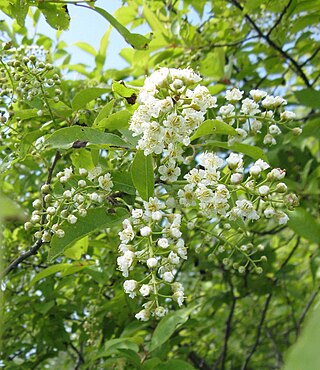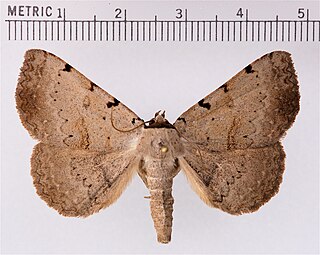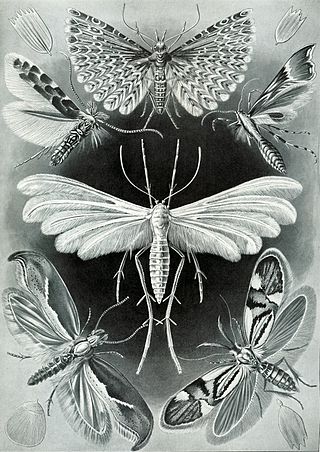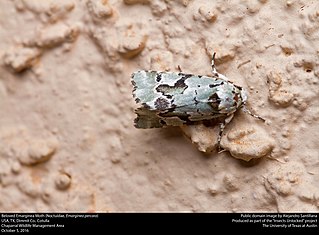
Yucca is a genus of perennial shrubs and trees in the family Asparagaceae, subfamily Agavoideae. Its 40–50 species are notable for their rosettes of evergreen, tough, sword-shaped leaves and large terminal panicles of white or whitish flowers. They are native to the Americas and the Caribbean in a wide range of habitats, from humid rainforest and wet subtropical ecosystems to the hot and dry (arid) deserts and savanna.

The Noctuidae, commonly known as owlet moths, cutworms or armyworms, are a family of moths. They are considered the most controversial family in the superfamily Noctuoidea because many of the clades are constantly changing, along with the other families of the Noctuoidea. It was considered the largest family in Lepidoptera for a long time, but after regrouping Lymantriinae, Catocalinae and Calpinae within the family Erebidae, the latter holds this title now. Currently, Noctuidae is the second largest family in Noctuoidea, with about 1,089 genera and 11,772 species. This classification is still contingent, as more changes continue to appear between Noctuidae and Erebidae.

The Arctiinae are a large and diverse subfamily of moths with around 11,000 species found all over the world, including 6,000 neotropical species. This subfamily includes the groups commonly known as tiger moths, which usually have bright colours, footmen, which are usually much drabber, lichen moths, and wasp moths. Many species have "hairy" caterpillars that are popularly known as woolly bears or woolly worms. The scientific name Arctiinae refers to this hairiness. Some species within the Arctiinae have the word "tussock"' in their common names because they have been misidentified as members of the Lymantriinae subfamily based on the characteristics of the larvae.

The Tortricidae are a family of moths, commonly known as tortrix moths or leafroller moths, in the order Lepidoptera. This large family has over 11,000 species described, and is the sole member of the superfamily Tortricoidea, although the genus Heliocosma is sometimes placed within this superfamily. Many of these are economically important pests. Olethreutidae is a junior synonym. The typical resting posture is with the wings folded back, producing a rather rounded profile.

The Pyralidae, commonly called pyralid moths, snout moths or grass moths, are a family of Lepidoptera in the ditrysian superfamily Pyraloidea. In many classifications, the grass moths (Crambidae) are included in the Pyralidae as a subfamily, making the combined group one of the largest families in the Lepidoptera. The latest review by Eugene G. Munroe and Maria Alma Solis retain the Crambidae as a full family of Pyraloidea.

Prunus virginiana, commonly called bitter-berry, chokecherry, Virginia bird cherry, and western chokecherry, is a species of bird cherry native to North America.

The erebid moth Ascalapha odorata, commonly known as the black witch, is a large bat-shaped, dark-colored nocturnal moth, normally ranging from the southern United States to Brazil. Ascalapha odorata is also migratory into Canada and most states of United States. It is the largest noctuoid in the continental United States. In the folklore of many Central American cultures, it is associated with death or misfortune.
Doidae is a family of Lepidoptera first described by Julian P. Donahue and John W. Brown in 1987. Species in Doidae had previously been placed in the Arctiidae, Lymantriidae and the Dioptidae.

The Catocalini are a tribe of moths in the family Erebidae. Adults of many species in the tribe are called underwing moths due to their vividly colored hindwings that are often covered by contrastingly dark, drab forewings.

The Phaegopterina are a subtribe of tiger moths in the tribe Arctiini, which is part of the family Erebidae. The subtribe was described by William Forsell Kirby in 1892. 469 species of Phaegopterina are present and 52 that are recently discovered in Brazil.

Apantesis is a genus of tiger moths in the family Erebidae first described by Francis Walker in 1855. They are found in North and Central America.

The Erebidae are a family of moths in the superfamily Noctuoidea. The family is among the largest families of moths by species count and contains a wide variety of well-known macromoth groups. The family includes the underwings (Catocala); litter moths (Herminiinae); tiger, lichen, and wasp moths (Arctiinae); tussock moths (Lymantriinae), including the arctic woolly bear moth ; piercing moths ; micronoctuoid moths (Micronoctuini); snout moths (Hypeninae); and zales, though many of these common names can also refer to moths outside the Erebidae. Some of the erebid moths are called owlets.

The Euchromiina are a subtribe of tiger moths in the family Erebidae. It was described by Arthur Gardiner Butler in 1876. Many species in the subtribe are mimics of wasps. Euchromiina have always been considered closely related to the subtribe Ctenuchina due to their similarity to moths and wasps. These two subtribes make up around 3,000 valid species, the majority of which occur in the Neotropics.

Annette Frances Braun was an American entomologist and leading authority on microlepidoptera, a grouping of mostly small and nocturnal moths. Her special interest was leaf miners: moths whose larvae live and feed from within a leaf.
Ronald William Hodges, known as Ron, was an American entomologist and lepidopterist.
Noctuini is a tribe of owlet moths in the family Noctuidae. There are at least 520 described species in Noctuini.
Caberini is a tribe of geometrid moths in the family Geometridae. There are at least 50 described species in Caberini.

Psaphidini is a tribe of owlet moths in the family Noctuidae. There are at least 40 genera and at least 90 described species in Psaphidini.

A MONA number, or Hodges number after Ronald W. Hodges, is part of a numbering system for North American moths found north of Mexico in the Continental United States and Canada, as well as the island of Greenland. Introduced in 1983 by Hodges through the publication of Check List of the Lepidoptera of America North of Mexico, the system began an ongoing numeration process in order to compile a list of the over 12,000 moths of North America north of Mexico. The system numbers moths within the same family close together for identification purposes. For example, the species Epimartyria auricrinella begins the numbering system at 0001 while Epimartyria pardella is numbered 0002.













